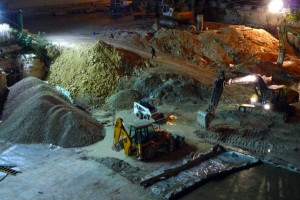One thing that hits you in Beirut is the constant commotion. The air is always laden with shouting, drilling, generator chugging, car alarms, sirens, wedding fireworks and screeching brakes. Drivers voluntarily add to the noise by leaning on their horns at random but frequent occasions. The result is a healthy din. All this type of noise means peace and prosperity. Making noise means you are alive. When there is peace, the Lebanese build on Sundays, on bank holidays, they build in the dark, huge beams lighting up multi-storey buildings after the swift nightfall. Cranes mushroom across the city overnight adding storey after storey of luxury apartments and office blocks.
In sharp contrast, at times of fighting all is quiet save for the dry staccato of machine guns and the more substantial thud of RPGs. Unless the gun battles are on your doorstep, this is often quieter than an average day of peacetime cacophony. In May 2008, when Hizbollah fought for,
and obtained, control of western Beirut and camped out in the spanking new city centre, the trendy, heaving bar strip of Gemayyzé just east of the downtown fell abruptly silent and dark. The spirited, self-assured pubbers and clubbers that had ruled the night disappeared like mice in the shadow of a predator. We couldn’t even pick out which were the bars we’d been in the nights before. There was a leak in the water pipe so the taps ran dry while water trickled across the street for four days but no-one came to fix it. No road works, no pneumatic drill, no men shouting over how to get the job done, only the echo of rockets and rattling bullets a kilometre away, like a ping-pong game in the other room. Then Hizbollah handed western Beirut back to the army, the airport reopened, a president was elected and life began again in a hurry. Peacetime bedlam replaced the deadly hush of entire neighbourhoods making seasoned calculations on the distance of the fighters. The marks of the conflict fade into those of previous battles and its impossible to tell which of the bullet holes are an update on the older scars of the eighties.
